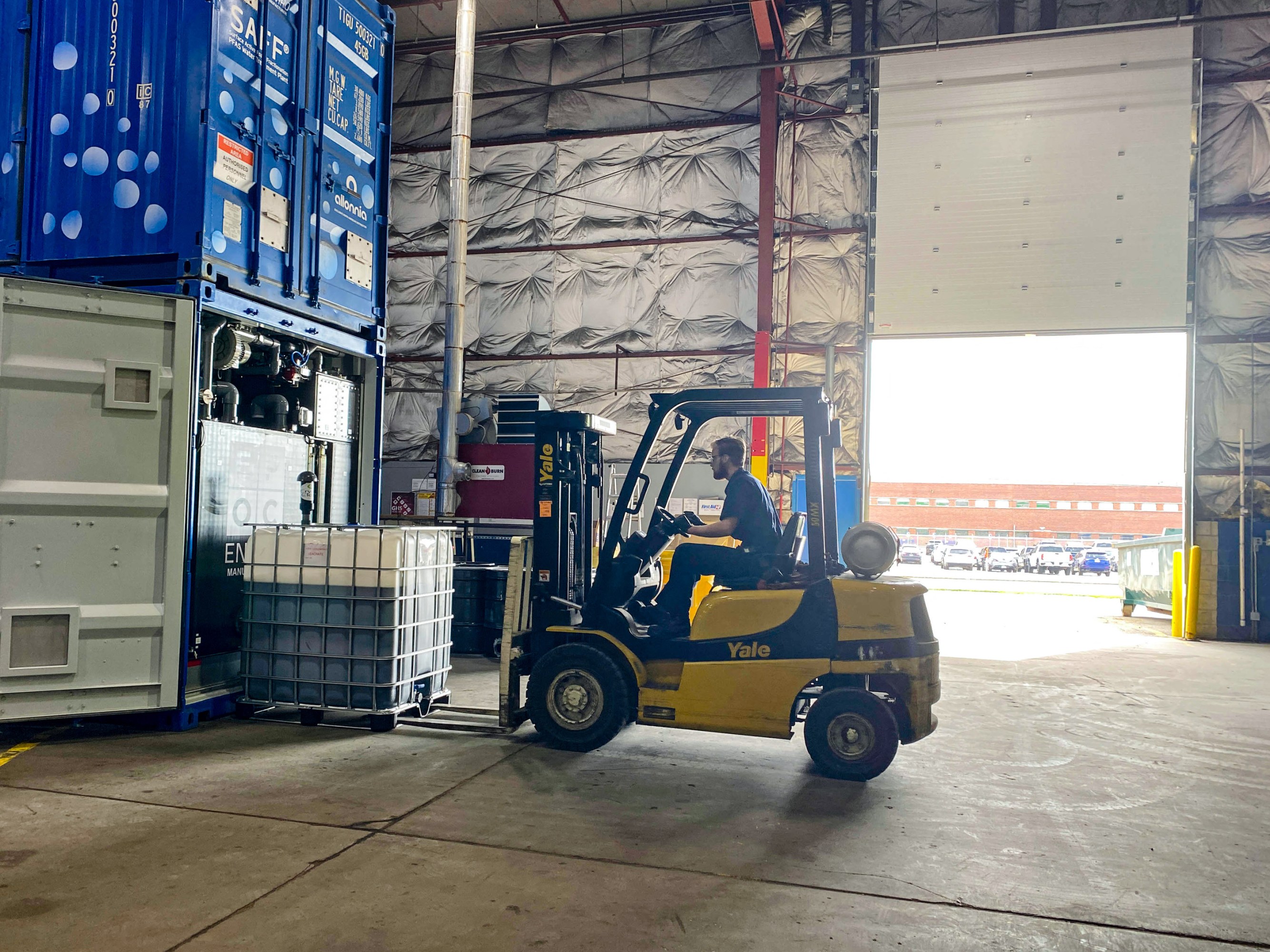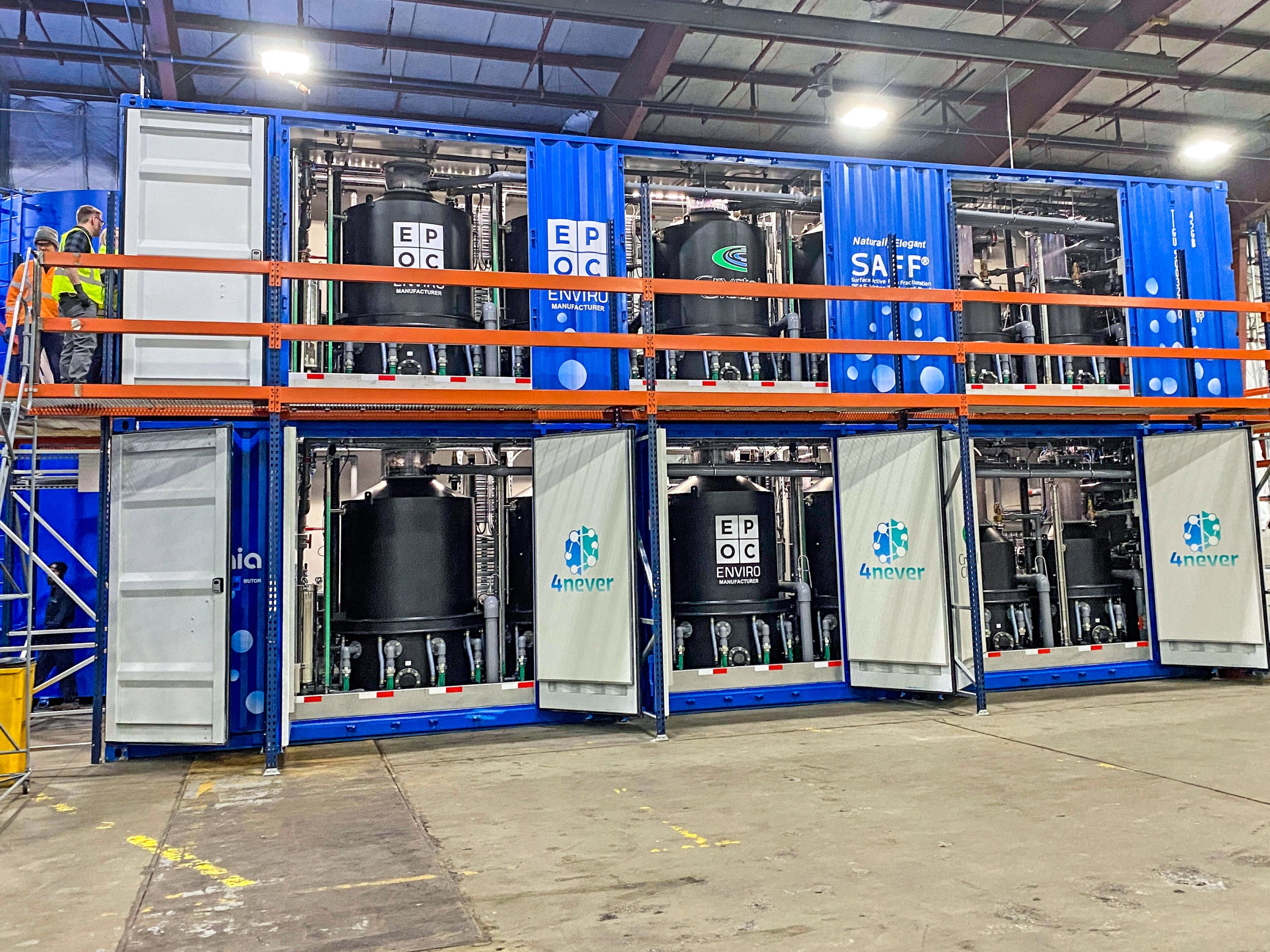The race to destroy PFAS, the forever chemicals
Scientists are showing these damaging compounds can be beat.

The PFAS sample slides around the inside of the plastic jar when I swirl it, dark and murky, like thin maple syrup. For many, these toxic so-called “forever chemicals” amount to something of a specter, having crept into our lives—and bodies—quietly for more than half a century. In the environment, PFAS are clear and odorless. We may hear about them in the headlines, consider them when we turn on the tap for a glass of water or a shower, but we don’t see them. We can’t touch them. Except that’s exactly what I find myself doing.
PFAS stands for “per- and polyfluoroalkyl substances,” a family of upwards of 15,000 or more human-made and incredibly durable chemical compounds that have been used in countless industrial and consumer applications for decades. Firefighting foams, waterproof hiking boots, raincoats, nonstick frying pans, dental floss, lipstick, and even the ink used to label packaging—all can contain PFAS. The compounds are ubiquitous in drinking water and soil, even migrating to Arctic sea ice. PFAS are called forever chemicals because once present in the environment, they do not degrade or break down. They accumulate, are transferred throughout the watershed, and ultimately persist.
The quest to reduce the amount of PFAS in the environment is what led me to an industrial park in a southern suburb of Grand Rapids, Michigan. The jar of PFAS concentrate in my hand is part of a demonstration arranged by my hosts, Revive Environmental, during a tour of the company’s PFAS destruction site, one of the first in the country to operate commercially and at scale. A few yards in front of me sits the company’s PFAS “Annihilator” in a white shipping container.
The Annihilator represents just one of several technologies now vying to break down and destroy PFAS. These span the gamut from established processes like electrochemical oxidation and supercritical water oxidation to emerging techniques relying on ultraviolet light, plasma, ultrasound, or catalyst-driven thermal processes. Some are deployed in field tests. Other companies are actively running pilot programs, many with various divisions of the US Department of Defense and other government agencies. And many other technologies are still undergoing laboratory research.
There’s good reason for this. Not only are PFAS everywhere around us; they’re also in us. Humans can’t break down PFAS, and our bodies struggle to clear them from our systems. Studies suggest they’re in my blood and yours—the majority of Americans’, in fact—and they have been linked to increased risks of kidney and testicular cancer, decreased infant birthweights, and high blood pressure. And that’s only what we know about now: researchers continue to grapple with the full impacts of PFAS on human and environmental health.
Revive’s Annihilator and other nascent destruction technologies show the first signs of promise that these “forever chemicals” can be removed from the environment permanently, limiting further human exposure and risk. But destroying PFAS is only one step in the full remediation process. Across the globe, researchers are developing new technologies and techniques to better understand, test, and track the chemicals—as well as identifying alternative materials—to eliminate PFAS for good.
Breaking it down
PFAS traces back to the mid-20th century, when the chemical giant 3M invented PFOA (perfluorooctanoic acid) to prevent nonstick coatings from clumping during production. Eventually, 3M began selling the material to fellow chemical companies, including DuPont, which used the material for its then revolutionary coating, Teflon. Later other manufacturers, such as Chemours and Corteva, would develop and produce their own brands. The health impacts of PFAS and extent to which the chemicals had pervaded the environment wouldn’t be discovered until the early 2000s, when legal action against DuPont unearthed evidence that chemical companies knew some of the risks PFAS posed to human health yet intentionally dumped them into waterways and unprotected holding ponds, where they eventually made their way into drinking water and people.
Though it has been years since the initial hazards of PFAS were made public, scientists and regulators have since struggled with how best to remediate the contamination and keep people safe. Traditionally, PFAS are treated through standard water filtration methods: granular activated carbon, reverse osmosis, ion exchange resins. These methods work extraordinarily well to capture PFAS. The problem is, though, that once captured, the chemicals don’t go away. The filters are discarded or chemically washed for reuse, and the notoriously clingy PFAS reenter the environment through landfills and wastewater. Incineration—another traditional mitigation technique—risks sending undestroyed PFAS compounds up the smokestack and into the air. All the while, PFAS continue to be manufactured, used, discarded, and circulated through the environment. And so the hunt is on for a way to make the forever chemicals a bit more ephemeral.
For the Annihilator, Revive uses a destruction method called supercritical water oxidation (SCWO) to cleave the durable carbon fluorine bonds that characterize PFAS compounds. In another shipping container, which serves as the monitoring station for the Annihilator, David Trueba points to a bank of computer monitors displaying data from the various sensors inside the destruction device. Trueba is the president and CEO of Revive and serves as one of my guides on the tour. SCWO is essentially a PFAS pressure cooker, he explains, heating and compressing the contaminated liquid to a supercritical state of above 500 °C and 3,200 PSI. In that state, where water is caught in a sort of purgatory between liquid and gas, oxygen becomes soluble, and the resulting oxidation drives the reaction that ultimately destroys the PFAS. Among other applications, SCWO has been used to decommission and destroy old stockpiles of mustard gas, the brutal chemical weapon that plagued the trenches of World War I. Battelle, a national research nonprofit, adapted SCWO to target PFAS and spun off Revive as a private entity with investment from Viking Global Investors in January 2023.

After the PFAS is destroyed, the solution undergoes several post-treatment procedures. Then it’s cooled and pumped into plastic totes for storage and eventual discharge to the local wastewater treatment plant. The finished product is aqua blue, resembling water you might see at a Caribbean beach, and Trueba says it tests below Michigan’s maximum contaminant level standards for PFAS.
Approaches and targets
Revive’s destruction operation targets PFAS in landfill leachate—a scientific term for what occurs when rainwater passes through landfill waste, absorbing chemicals and contaminants from the decomposing material along the way. Landfill leachate is one of the primary sources of PFAS contamination, which is unsurprising since that’s where many PFAS-laden products end up.
Earlier in the tour we’d walked to an adjacent facility where a pair of workers, clad in heavy jumpsuits, hard hats, and boots, manned a hose running from the back of a polished-steel semi-trailer. The workers were pumping leachate trucked from a nearby landfill by Heritage-Crystal Clean, an environmental services company that’s partnered with Revive. The smell was about what you’d expect from a brown, sludgy cocktail of decomposition.
“It’s the smell of money,” Trueba said. Later, he told me: “Innovation, in my mind, is not just an idea, but it’s getting paid for it. It’s getting the value in the market because the market values that it’s being adopted.”
That may sound a bit brutally capitalistic for a widespread societal issue like PFAS, yet experts point to the very real-world issues of cost facing the companies and municipalities footing the bill for PFAS destruction. As much as there’s a race to destroy PFAS, there’s also a race to do it as cost-effectively and efficiently as possible. And Revive, with its brand of SCWO technology, isn’t the only one running the track.
“It’s important that this problem isn’t a tens or hundreds of trillion dollars problem. It needs to be kept to, like, a multibillion-dollar problem,” says Daniel Cho, founder and CEO of Onvector, a water treatment company using plasma technology to destroy PFAS.
Video of Onvector’s technology shows a bright-blue flickering light, similar to a welding arc, accompanied by a high-pitched screech. During our conversation, Cho refers to the technology as “lightning and fire reliably delivered inside a flowing cyclone of water.” It’s a catchy phrase, meant to contain several PhDs’ worth of science in a neat, memorable package. In reality, the technicalities are more complex.
Onvector’s technology combines the actions of a centrifugal separator with an electrode that ionizes gas injected into the device. The resulting reaction creates high-energy electrons that attack and break down the PFAS compounds. The system is currently deployed at Joint Base Cape Cod in Massachusetts and was partially supported through grant funding from AFWERX, the skunkworks division of the US Air Force. Cho expects to fully scale Onvector in 2024, he says.
Another promising PFAS destruction technology is under development by Washington-based Aquagga. The company uses a method known as HALT (hydrothermal alkaline treatment), a sort of cousin to the SCWO process used by Revive. HALT also relies on pressure and heat to destroy PFAS, but it introduces sodium hydroxide as a catalyst before treatment. This allows PFAS to be treated at much lower temperatures than SCWO, says Brian Pinkard, Aquagga’s cofounder and chief technology officer.
Like SCWO, the technology was first developed to treat stockpiles of chemical weapons. Researchers from the Colorado School of Mines adapted it to destroy PFAS and licensed Aquagga to deploy it commercially. Pinkard was exposed to the foundations of HALT technology while working on his doctorate at the University of Washington, which involved decommissioning stockpiles of deadly nerve agents like sarin and VX gas. He views PFAS destruction and chemical weapons destruction as similar “problem sets.”
“You have this toxic waste. Nobody wants to transport it. Nobody wants to burn it,” Pinkard says. “Everyone wants to have a system they can bring on-site, plug it into a barrel or tote, process the waste on-site, and turn it into nontoxic byproducts.”
While these and other emerging destruction technologies show promise, there’s no single solution to eliminate PFAS from the environment, and each technology presents its own challenges. SCWO struggles with high concentrations of salt and requires pretreatment to remove it. The process also yields hydrofluoric acid, which Revive must neutralize before the cleaned liquid can reenter the municipal water system. HALT requires its sodium hydroxide catalyst to function, while plasma has yet to prove cost-effective at scale. Meanwhile, other companies are developing methods of treating PFAS in solid matter.
Then there’s the matter of which specific PFAS chemicals are actually being destroyed. Numbers vary widely, but experts estimate that between 6,000 and 15,000 separate PFAS compounds exist. Destruction technologies are effective at eliminating some of them, like the PFOS and PFOA subgroups widely used in industrial and consumer applications. However, these compounds also happen to be the most widely understood and regulated by state environmental agencies. Thousands more are understudied and undertested, and the jury is still out on whether existing destruction technologies can eliminate them. Even foam fractionation, a popular and efficient method for separating and concentrating PFAS prior to destruction, struggles to collect PFAS compounds that aren’t as susceptible to foaming.


A worker loads PFAS-contaminated leachate into the PFAS Annihilator.
These uncertainties fuel a good deal of conjecture and jockeying among PFAS destruction companies. Access to a substantial untapped market is on the line, and some companies are quick to hold up their own technologies as the end game. The reality is, though, it will likely take a range of mature technologies, each deployed in situations matching their strengths, to solve the problem.
“Bottom line is that the way that we approach treatment will be very site dependent, and we think that it is best to have several options,” a senior US Defense Department official said in an interview with MIT Technology Review.
The DoD is one of the primary drivers of research on PFAS destruction, having funded, in some way, many of the technologies being used today. Much of the work the DoD has supported is aimed at contamination around military installations. For years, the US military sprayed a material known as aqueous film forming foam (AFFF) to put out fires, whether in training or in real-world situations. AFFF is chock-full of some of the most harmful PFAS compounds, and the DoD has since spent substantial money and effort trying to remediate the resulting pollution.
The DoD agencies that conduct environmental R&D and validation have funded $160 million worth of PFAS destruction and related projects alone since taking up the charge in 2009, according to the department official. Outside the DoD, the Biden administration also recently made the issue a key priority, allocating $5 billion from its 2023 Bipartisan Infrastructure Law to address PFAS contamination.
Decades of proliferation
Despite the progress on destruction technologies, the physical (or chemical) act of destroying PFAS represents only a fraction of the work required to rid the environment of these compounds for good. Repurposing the traditional remediation technologies and techniques used to treat major contaminants like chlorinated hydrocarbons (including PCBs), pesticides (including DDT), and lead simply won’t cut it with PFAS, says Philip Simon, founder and president of Ann Arbor Technical Services, an environmental consulting firm based in Michigan. PFAS, in many cases, require a rewrite of the remediation playbook.
“You’ve got a lot of compounds used very broadly in commerce in an unregulated setting for 70 years,” Simon says. “That never happened with PCBs—never. That didn’t happen with chlorinated pesticides. So if you think that DDT and chlorinated pesticides, and then later PCBs, foreshadow what we’re up against here, forget it. It’s way more complicated than that.”
While the PFAS playbook is still being written, part of the work involves new methods of environmental forensics, a field essentially amounting to chemical detective work. PFAS—and other contaminants—all have their own chemical fingerprints, says Simon. Manufacturers use slightly different chemistries and processes when creating the compounds. These differences, and the impurities introduced along the way, give PFAS unique signatures that forensics experts can trace back to the source. This type of intelligence provides a more accurate picture of the specific types of PFAS present at a contamination site, making more targeted treatments possible. Going forward, forensics is also likely to play a pivotal role in determining which parties are responsible for releasing PFAS and should therefore fund remediation efforts, Simon says.
The DoD began funding forensics projects related to PFAS in 2020 and has since supported projects including creating a forensic library of PFAS compounds, developing mobile labs for rapid PFAS analysis, and using machine-learning models for PFAS recognition and analysis.
Even more important than eliminating the PFAS already in the environment is ensuring that they’re no longer used, or even made, in the first place. There’s been substantial progress in this area: with the cloud of national-scale PFAS regulation looming and customers becoming increasingly aware of the potential health risks, more companies are diving into their supply chains to find where the PFAS are and how to source replacements, says Shari Franjevic, program manager at GreenScreen for Safer Chemicals, which provides certifications for products free of PFAS and other harmful substances. GreenScreen’s website lists around 150 products the organization has deemed safe, including chemicals for textile manufacturing, cleaning, food service, and firefighting. The DoD is also funding research into alternative firefighting foams that meet military standards, several of which show “promise,” according to the defense official.
In many cases, compounds that were used before the widespread introduction of PFAS still offer viable and safer alternatives, Franjevic says, citing the natural waxes once common in dental floss and food packaging.
“I think that when people think about alternatives, they make the assumption that new chemistry must be invented or found,” Franjevic says. “And in most cases, it’s just not true, because there are historical products that used other chemistries.”
Major chemical manufacturers have also begun yielding to mounting pressure to cease PFAS production and answer for their roles, and often their complacency, in PFAS contamination. In mid-2023, 3M agreed to a $10.3 billion settlement to fund remediation of PFAS in public water for the next 13 years. The settlement comes on the heels of 3M’s announcement in late 2022 that it would stop all production of PFAS by 2025. Other major PFAS manufacturers, including DuPont, Chemours, and Corteva, agreed to a nearly $1.2 billion settlement regarding their roles in PFAS production and contamination in mid-2022.
Weaning both industry and consumers off PFAS is proving an uphill battle, though. Like chemical vigilantes, these compounds may leave a mess in their wake, but it’s hard to dispute their effectiveness. While 3M may plan to stop production, numerous other chemical companies across the globe still manufacture PFAS, and the willingness to adopt alternatives varies by industry.
“That notion of peak PFAS, I think, is still very, very elusive,” Cho of Onvector says. “We have to control how we make it or [determine] what the essential uses are.”
In food packaging, for example, PFAS are typically used as a grease or liquid barrier on products including pizza boxes, drinking straws, and disposable coffee cups. While PFAS-free food packaging exists in the market, most doesn’t live up to the performance or cost standards demanded by industry, says Keith Vorst, director of the Polymer and Food Protection Consortium and associate professor in the Department of Food Science and Human Nutrition at Iowa State University. “I don’t know that the brand owners are willing to give up performance,” Vorst says. “There’s too much fear.”
Iowa State scientists, including Vorst and his colleague Greg Curtzwiler, are experimenting with embedding polymers and binding agents into agricultural byproducts like coffee grounds and cassava root to create packaging without “intentionally-added PFAS,” Vorst says.
The phrase “intentionally-added” underscores just how prickly the PFAS problem is. Because the compounds are so widespread in the environment, a product may inadvertently take them up through the materials, including water, used to produce it, Vorst says. He notes that products containing recycled and recovered materials are particularly susceptible to PFAS exposure because those recycled materials, like paper, may already be contaminated.
The complexity and pervasiveness of PFAS make remediation overwhelmingly difficult, though progress is being made. Vast amounts of time and resources have been dedicated to understanding the compounds’ chemical personalities, their vulnerabilities, and their implications for the environment and human health. But the progress that has been made has come from people and groups battling significant headwinds: environmental indifference, political skittishness, and industry obfuscation. The sense among those I interviewed suggests that all this work is now coalescing, just waiting for a nudge over the edge to really gain momentum and enact lasting change. Many believe that nudge will come in the form of federal regulation.
In March 2023, the US Environmental Protection Agency proposed national drinking water standards for six PFAS compounds as part of the agency’s PFAS Strategic Roadmap. These standards amount to suggestions at this point, but industry insiders expect regulations regarding PFAS contamination in water, soil, and other parts of the environment to be adopted by the end of 2024. The European Union is also exploring sweeping restrictions on the manufacture and use of PFAS. In Australia, New South Wales and South Australia have both banned the use of PFAS-laden firefighting foams, and the Australian government’s Department of Climate Change, Energy, the Environment, and Water is developing a national PFAS management plan. Once regulations take effect, everyone from private landfill owners and municipalities to manufacturers will be compelled to examine their role in handling PFAS and make investments to remove the compounds from their process or destroy them altogether.
In the US, however, in the absence of strict federal guidelines, PFAS regulation has thus far been left in the hands of individual states. “The states are acting on their own timeline. Some of them are waiting to see what the federal government does. Some are moving faster,” says Pinkard of Aquagga. “It’s all happening in real time. It’s changed a lot even in the last year.” Some states, like Michigan, Maine, and Wisconsin, have developed enforceable drinking-water standards. But many others have stopped far short of enforceable regulations, with some doing nothing at all to regulate PFAS.
“People aren’t going to treat water beyond what they’re regulatorily required,” Cho says. He also notes that “the lack of nationally harmonized regulations on PFAS has been a major obstacle toward the evolution in this [PFAS destruction] space.”
Ultimately, the degree to which PFAS is removed from the environment will come down to the collective will of regulators, industry, and society at large. While policymakers inch closer to regulation and private industry sweats it out over liability and risk, researchers developing destruction technologies plan to continue demonstrating that even forever chemicals are far from invincible.
John Wiegand is a freelance journalist based in Michigan.
Keep Reading
Most Popular
Large language models can do jaw-dropping things. But nobody knows exactly why.
And that's a problem. Figuring it out is one of the biggest scientific puzzles of our time and a crucial step towards controlling more powerful future models.
How scientists traced a mysterious covid case back to six toilets
When wastewater surveillance turns into a hunt for a single infected individual, the ethics get tricky.
The problem with plug-in hybrids? Their drivers.
Plug-in hybrids are often sold as a transition to EVs, but new data from Europe shows we’re still underestimating the emissions they produce.
Stay connected
Get the latest updates from
MIT Technology Review
Discover special offers, top stories, upcoming events, and more.